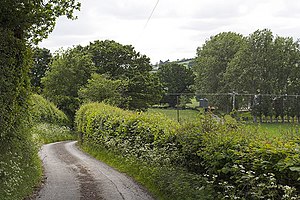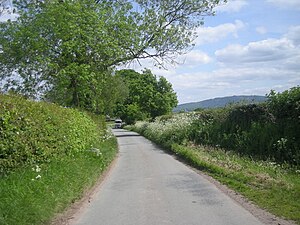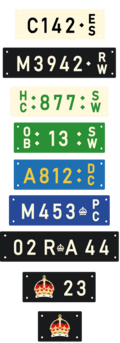Roads in Great Nortend: Difference between revisions
| (15 intermediate revisions by the same user not shown) | |||
| Line 1: | Line 1: | ||
'''Roads''' | [[File:Country_lane_near_Llyn_Ebyr_-_geograph.org.uk_-_478532.jpg|thumb|A typical country road in Great Nortend.]]'''Roads''' or '''public carriageways''' are an indispensable part of the Nortish civil infrastructure and includes over 100,000 miles of recognised carriageway. Road distances are shewn in miles, furlongs and yards while speed limits are given in miles per hour. Vehicles pass oncoming traffic on the left. Though [[Great Nortend]] relies less heavily on its road network for long-distance travel than many other countries, preferring rail travel instead, road transport remains crucial for short to medium distance journeys. | ||
Motor vehicles make up only around a quarter of the total number of vehicles registered in Great Nortend, with various forms of horse-drawn waggon, cart or carriage forming the bulk of private vehicular registrations in the country. Many motor vehicles are public vehicles, such as taximeter and omnibus carriages or vans and lorries used for commerce, logistics or trade. Private motor carriages are relatively rare in Great Nortend and mainly the preserve of the rich, owing to the high cost of registration and driver licensing. | |||
=== | ==Road network== | ||
===Classification=== | |||
[[File:Country_road_at_Withington,_in_Shropshire,_England.jpg|thumb|right|The main metalled highway linking Polton and Sale.]] | |||
The ''Roads and Highways Act'' is primarily concerned with the allocation of responsibility for the building and upkeep of carriageways, and the law that relates to travel thereupon. All public carriageways for vehicular traffic are considered „roads” while some more significant roads have the status of a „highway”, although this term and classification covers all roads controlled by the Crown as „the King’s highway”. | |||
A highway is a public carriageway which provides a relatively straight and often flat, metalled road surface, typically linking towns and cities. The most significant highways are the numerous highways through the Monmorians. Historically tolled highways were common through Great Nortend, especially during the 18th and 19th centuries, however with the increase in rail transport, they have gradually lost their profitability and many have been turned into public carriageways. | |||
A | |||
Highways are maintained by the Board of Highways, under Office of Works. Ordinary roads, which may be lanes, streets, droves or any number of other roads, are maintained by local parish vestries or councils and usually have gravelled or even dirt surfaces. There is a maximum open road speed limit of 60 m.p.h. However, many roads have lower limits owing to poor visibility. | |||
Most roads and all highways are named. Numerical designations are given to all highways (divided into A and B highways); however, these are generally not in popular use. | |||
=== | ===Signage=== | ||
[[File:Old_Road_Jubction_Sign.jpg|thumb|right|Typical sign warning of a junction ahead.]] | |||
Signs on the Nortish road network generally conform to the standards published by the Board of Highways, although local roads may deviate. All length distances are given in miles, or furlongs and yards depending on magnitude. Milestones are placed along many highways. Speed is given in miles per hour while height and width measurements are given in feet and inches. Weight is given in tons and hundredweight. | |||
Signs are classed as prohibitory, mandatory, warning or informative. | |||
Prohibitory signs consist of a solid red circle, with or without an additional plate underneath specifying the prohibition. These may be signs giving weight restrictions for bridges, forbidding parking or forbidding particular turns. Otherwise, a plain red disc indicates a blanket „no entry” for all vehicular traffic. Red discs are similarly displayed on level crossing gates or hand-held signs. | |||
A mandatory sign consists of a red ring with or without a specific plate. These may specify a speed restriction, a required manoeuvre or specify parking limits. Some prohibitory and mandatory signs have the specifics of the sign incorporated into the circular disc, without an accompanying plate. | |||
A warning sign consists of a red hollow triangle, almost always with a specific plate underneath (except in the case of a warning triangle placed to warn of an upcoming hazard). | |||
At crossroads or junctions, there often is placed a slow sign which is a special sign combining the mandatory and warning signs consisting of a red ring with a red hollow triangle within. Vehicles are not required necessarily to halt, but must slow and give way or yield to oncoming traffic. | |||
== | ==Driving== | ||
For instance, oncoming vehicles are passed on the left hand side. However, except on roads with a solid dividing line, there is no requirement to keep one's vehicle or carriage on the left side of the road unless there is oncoming traffic. Drivers on public carriageways are bound by the Carriageway Rules, which prescribe the mandatory rules for driving including signalling, permitted manoeuvres, priority and signs. The Carriageway Rules are condensed into Carriageway Rulebook, of which every driver is required to keep an updated copy. While bicycles, pedestrians and ridden horses are not considered carriages, all users of public carriageways are bound by the Carriageway Laws. | |||
=== | ===Licensing and registration duties=== | ||
Driving licences are required for drivers driving most horse-drawn or motor vehicles. The minimum age for driving a horse-drawn vehicle is 14 and for driving a motor vehicle is 18. Driving licences are issued after examination and consist of a paper booklet. While licences for driving a horse-drawn vehicle do not expire and are relatively easy and cheap to acquire, motor vehicle licences expire every three years and require renewal by re-examination. Furthermore, motor vehicle licences are fairly expensive. | |||
=== | ====Number plates==== | ||
[[File:GNnumberplates.png|120px|thumbnail|right|The typical design of number plates.]]Number plates are required in [[Great Nortend]] for all registered motorcars, vans, lorries, horse-drawn carriages, coaches, carts, waggons and other such vehicles when used on public roads. Most number plates are made from enamel-painted pressed steel or iron. | |||
=== | '''General Purpose number plates''' | ||
General Purpose number plates are the standard issue number plate, being black on white at the front of the vehicle and white on black at the rear. The number plate format for general purpose number plates is NNN(...)·{{Su|p=C|b=C|lh=}} where N... are numbers issued consequentially, and {{Su|p=C|b=C|lh=}} the issuing authority county code. | |||
'''Hire carriages''' | |||
Hire carriages have green and white number plates bearing the letters {{Su|p=H|b=C}}. Hire carriages include taximeter cabriolets, Hackney carriages and other 'taxi' vehicles, but do not include hire vehicles. Instead of single separator dots, double dots are used. | |||
'''Omnibus carriages''' | |||
Omnibus have green and white number plates in a similar fashion to hire carriage number plates. Omnibus and trolley omnibus carriages use the same number plates, which do not have a minimum number (e.g. 4 is used instead of 004 as for general issue number plates). | |||
'''Corps Diplomatique''' | |||
Diplomatic number plates, issued to diplomats from foreign countries, are blue and white, and are otherwise identical to general issue plates, save for the double separator dots and the use of {{Su|p=C|b=D|lh=}} as the issuing authority code. | |||
'''Police vehicles''' | |||
Police vehicle number plates are navy and white. They are otherwise identical to general issue number plates, save for the use of a crown as the separator dot and the use of {{Su|p=P|b=C|lh=}}, standing for Police Constabulary, as the issuing authority code | |||
'''Military and naval vehicles''' | |||
Military and naval vehicles have red and white number plates. The sequence is NN LL NN where N is a number and LL signifies the branch or corps issuing the number plate. A crown separates the two letters but no other separator is used. | |||
'''Government and Crown vehicles''' | |||
Official government number plates use a full-coloured crown with white text on black. Number plates are numbered in sequence, with the official carriage of the [[Lord High Treasurer of Great Nortend|Prime Minister]] numbered 8 and, ''exempli gratia'', a senior civil servant's chauffeured carriage at number 83. | Official government number plates use a full-coloured crown with white text on black. Number plates are numbered in sequence, with the official carriage of the [[Lord High Treasurer of Great Nortend|Prime Minister]] numbered 8 and, ''exempli gratia'', a senior civil servant's chauffeured carriage at number 83. | ||
The vehicles transporting the [[Monarchy of Great Nortend|King]] or other members of the Royal family | The vehicles transporting the [[Monarchy of Great Nortend|King]] or other members of the Royal family may use simply a crown as a number plate, in addition to the personal standard. | ||
{{Great Nortend}} | {{Great Nortend}} | ||
[[Category:Great Nortend]][[Category:Astyria]] | [[Category:Great Nortend]][[Category:Astyria]] | ||
Latest revision as of 00:01, 28 August 2024
Roads or public carriageways are an indispensable part of the Nortish civil infrastructure and includes over 100,000 miles of recognised carriageway. Road distances are shewn in miles, furlongs and yards while speed limits are given in miles per hour. Vehicles pass oncoming traffic on the left. Though Great Nortend relies less heavily on its road network for long-distance travel than many other countries, preferring rail travel instead, road transport remains crucial for short to medium distance journeys.
Motor vehicles make up only around a quarter of the total number of vehicles registered in Great Nortend, with various forms of horse-drawn waggon, cart or carriage forming the bulk of private vehicular registrations in the country. Many motor vehicles are public vehicles, such as taximeter and omnibus carriages or vans and lorries used for commerce, logistics or trade. Private motor carriages are relatively rare in Great Nortend and mainly the preserve of the rich, owing to the high cost of registration and driver licensing.
Road network
Classification
The Roads and Highways Act is primarily concerned with the allocation of responsibility for the building and upkeep of carriageways, and the law that relates to travel thereupon. All public carriageways for vehicular traffic are considered „roads” while some more significant roads have the status of a „highway”, although this term and classification covers all roads controlled by the Crown as „the King’s highway”.
A highway is a public carriageway which provides a relatively straight and often flat, metalled road surface, typically linking towns and cities. The most significant highways are the numerous highways through the Monmorians. Historically tolled highways were common through Great Nortend, especially during the 18th and 19th centuries, however with the increase in rail transport, they have gradually lost their profitability and many have been turned into public carriageways.
Highways are maintained by the Board of Highways, under Office of Works. Ordinary roads, which may be lanes, streets, droves or any number of other roads, are maintained by local parish vestries or councils and usually have gravelled or even dirt surfaces. There is a maximum open road speed limit of 60 m.p.h. However, many roads have lower limits owing to poor visibility.
Most roads and all highways are named. Numerical designations are given to all highways (divided into A and B highways); however, these are generally not in popular use.
Signage
Signs on the Nortish road network generally conform to the standards published by the Board of Highways, although local roads may deviate. All length distances are given in miles, or furlongs and yards depending on magnitude. Milestones are placed along many highways. Speed is given in miles per hour while height and width measurements are given in feet and inches. Weight is given in tons and hundredweight.
Signs are classed as prohibitory, mandatory, warning or informative.
Prohibitory signs consist of a solid red circle, with or without an additional plate underneath specifying the prohibition. These may be signs giving weight restrictions for bridges, forbidding parking or forbidding particular turns. Otherwise, a plain red disc indicates a blanket „no entry” for all vehicular traffic. Red discs are similarly displayed on level crossing gates or hand-held signs.
A mandatory sign consists of a red ring with or without a specific plate. These may specify a speed restriction, a required manoeuvre or specify parking limits. Some prohibitory and mandatory signs have the specifics of the sign incorporated into the circular disc, without an accompanying plate.
A warning sign consists of a red hollow triangle, almost always with a specific plate underneath (except in the case of a warning triangle placed to warn of an upcoming hazard).
At crossroads or junctions, there often is placed a slow sign which is a special sign combining the mandatory and warning signs consisting of a red ring with a red hollow triangle within. Vehicles are not required necessarily to halt, but must slow and give way or yield to oncoming traffic.
Driving
For instance, oncoming vehicles are passed on the left hand side. However, except on roads with a solid dividing line, there is no requirement to keep one's vehicle or carriage on the left side of the road unless there is oncoming traffic. Drivers on public carriageways are bound by the Carriageway Rules, which prescribe the mandatory rules for driving including signalling, permitted manoeuvres, priority and signs. The Carriageway Rules are condensed into Carriageway Rulebook, of which every driver is required to keep an updated copy. While bicycles, pedestrians and ridden horses are not considered carriages, all users of public carriageways are bound by the Carriageway Laws.
Licensing and registration duties
Driving licences are required for drivers driving most horse-drawn or motor vehicles. The minimum age for driving a horse-drawn vehicle is 14 and for driving a motor vehicle is 18. Driving licences are issued after examination and consist of a paper booklet. While licences for driving a horse-drawn vehicle do not expire and are relatively easy and cheap to acquire, motor vehicle licences expire every three years and require renewal by re-examination. Furthermore, motor vehicle licences are fairly expensive.
Number plates
Number plates are required in Great Nortend for all registered motorcars, vans, lorries, horse-drawn carriages, coaches, carts, waggons and other such vehicles when used on public roads. Most number plates are made from enamel-painted pressed steel or iron.
General Purpose number plates
General Purpose number plates are the standard issue number plate, being black on white at the front of the vehicle and white on black at the rear. The number plate format for general purpose number plates is NNN(...)·C
C where N... are numbers issued consequentially, and C
C the issuing authority county code.
Hire carriages
Hire carriages have green and white number plates bearing the letters H
C. Hire carriages include taximeter cabriolets, Hackney carriages and other 'taxi' vehicles, but do not include hire vehicles. Instead of single separator dots, double dots are used.
Omnibus carriages Omnibus have green and white number plates in a similar fashion to hire carriage number plates. Omnibus and trolley omnibus carriages use the same number plates, which do not have a minimum number (e.g. 4 is used instead of 004 as for general issue number plates).
Corps Diplomatique
Diplomatic number plates, issued to diplomats from foreign countries, are blue and white, and are otherwise identical to general issue plates, save for the double separator dots and the use of C
D as the issuing authority code.
Police vehicles
Police vehicle number plates are navy and white. They are otherwise identical to general issue number plates, save for the use of a crown as the separator dot and the use of P
C, standing for Police Constabulary, as the issuing authority code
Military and naval vehicles Military and naval vehicles have red and white number plates. The sequence is NN LL NN where N is a number and LL signifies the branch or corps issuing the number plate. A crown separates the two letters but no other separator is used.
Government and Crown vehicles Official government number plates use a full-coloured crown with white text on black. Number plates are numbered in sequence, with the official carriage of the Prime Minister numbered 8 and, exempli gratia, a senior civil servant's chauffeured carriage at number 83.
The vehicles transporting the King or other members of the Royal family may use simply a crown as a number plate, in addition to the personal standard.




